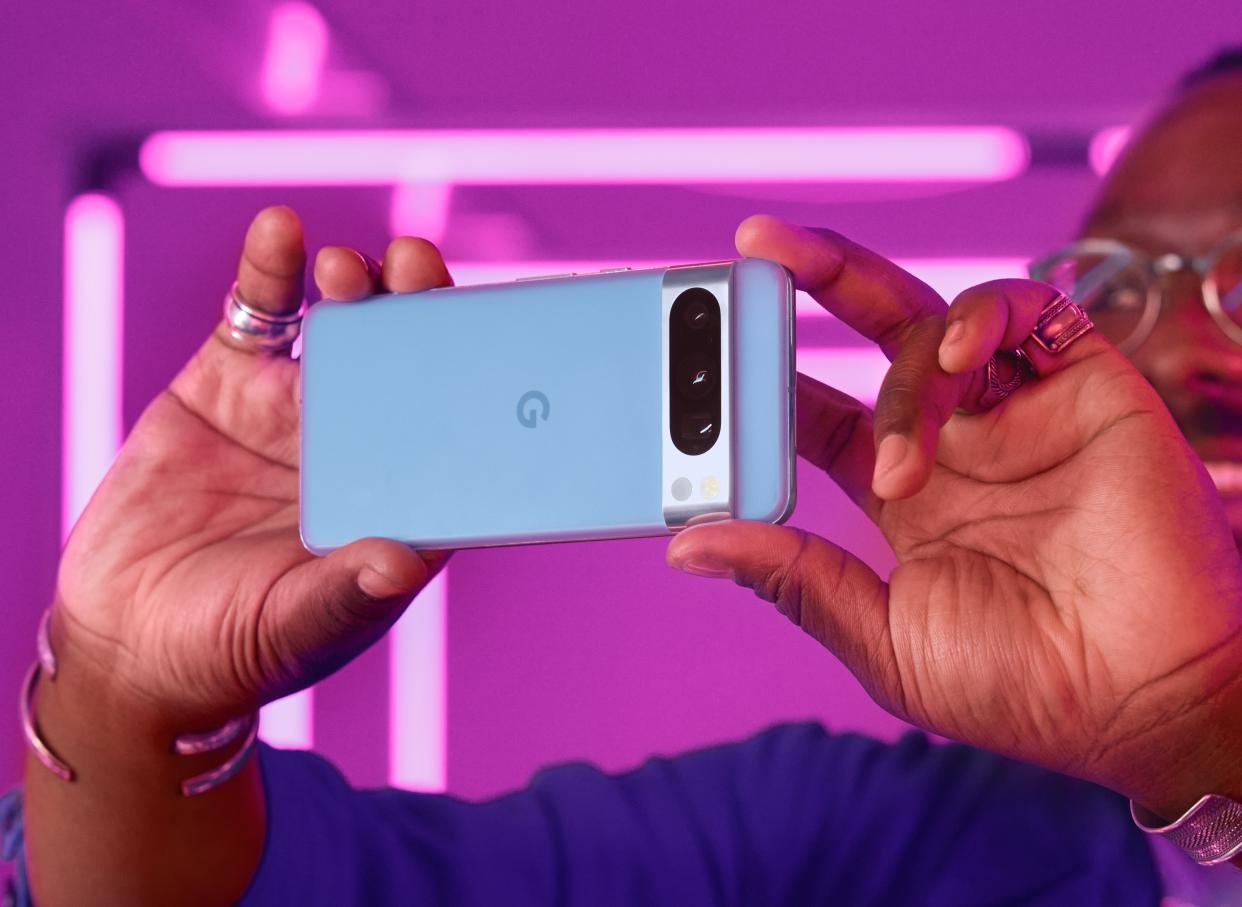Google debuts AI-powered Pixel 8 and Pixel 8 Pro smartphones
Google (GOOG, GOOGL) on Wednesday launched its new Pixel 8 and Pixel 8 Pro smartphones. The phones, which start at $699 and $999, respectively, serve as showcases for Google’s high-powered AI chops, including wild new photo and video capabilities, a smarter assistant that answers calls for you, and, in the case of the Pixel 8 Pro, a built-in thermometer. Yes, you read that right, a thermometer on a smartphone. And Google is working with the FDA to ensure it can capture your body temperature.
Like Apple’s (AAPL) iPhone 15 and iPhone 15 Pro, Google’s Pixel 8 and Pixel 8 Pro come with a number of the same features, but the Pixel Pro model gets just enough additional options to make it more appealing for consumers looking for a top-of-the-line smartphone.

The Pixel 8 comes with Google’s new 6.2-inch Actua OLED display with a screen refresh rate that tops out at 120 frames per second. So playing games or swiping through apps will look buttery smooth. But because a high screen refresh rate also devours battery life, Google says the Pixel 8 will throttle down to 60 frames per second when you’re not using demanding apps.
The Pixel 8 Pro comes with a 6.7-inch Super Actua OLED screen with an adjustable refresh rate of between 1 frame per second and 120 frames per second, helping to save even more battery life when using less intensive apps. The Pro’s screen can also get brighter than the standard Pixel 8— 2,400 nits, a measure of luminosity, versus 2,000 nits on the Pixel 8.
Both phones get slightly revamped designs with new colors including the Pixel 8 Pro’s new blue "Bay" hue, which would be my go-to choice.

Inside, the Pixel 8 and Pixel 8 Pro get Google’s newest Tensor G3 chip, which powers their various AI options including, thankfully, a Face Unlock feature that you can finally use to log into third-party apps and payment services. You’ve been able to use Apple’s Face ID to sign into apps and use Apple Pay for years, so it’s great to see Google adding the ability to the Pixel line.
On the camera front, the Pixel 8 gets a new 50-megapixel (MP) main camera sensor that captures 21% more light, meaning images will look more colorful in the daylight and clearer at night. The Pixel 8’s ultra-wide camera also gets autofocus, meaning it can capture macro photos for extreme closeups.
The Pixel 8 Pro also gets a 50-MP camera that lets in 21% more light as well as a 48-MP ultra-wide camera that lets in 105% more light and a 48-MP 5x optical telephoto camera for 56% more light. The Pro also gets professional camera controls that let you change specific photo settings for when you want to adjust the lighting and lens to capture a shot how you like it.
Then there’s the Pixel 8 Pro’s, um, built-in thermometer. The thermometer is strapped to the Pro’s rear panel just below its cameras. Google says it’s meant to be used to measure the temperature of things like beverages and cookware, but added that it’s working to get FDA approval to use it to measure body temperatures. There’s no word on how long that will take though.

The phones’ hardware is all well and good, but it’s the AI-powered software that really matters. Google has outfitted the Pixel 8 and Pixel 8 Pro with the same wild capabilities, meaning you don’t need to pony up any extra cash to get access to some slick AI.
Much of what Google has to offer is based around the Pixels’ cameras. There’s Magic Editor, which allows you to grab an object in your photo and either erase it or move it to some other part of the image with just a few taps. For example, if you have a picture of a little boy shooting a basketball at a hoop, you can grab the boy’s image, drag it up to the basket and make it look like he’s dunking. Magic Editor will then automatically fill in the background where he once stood to make it look like he was never there. You can even grab his shadow and move it underneath him as he’s dunking to make the photo look more realistic.
Importantly, Google says photos altered using Magic Editor will include metadata noting that they’ve been altered.
Then there’s Best Take, an AI feature meant to ensure everyone in a group photo looks their best. Everyone has shot a group image and had to retake it again because someone was looking down, or another person wasn’t smiling, or someone else blinked. Best Take uses the couple of pictures you’ve taken of the group, and pulls up the best photo of each person’s face. You can then select from the collection of each individual’s headshot to adjust the photo so that everyone is looking at the camera and smiling.
Audio Magic Eraser, meanwhile, is designed to remove extraneous background audio from your videos. So if you’re, say, recording a street musician playing music and a firetruck goes by in the background, you can use Audio Magic Eraser to take out the sound of the truck’s sirens while leaving in the sound of the musician playing.
Google is also adding its top-notch Night Sight mode to video, so you’ll be able to take videos with improved color and clarity in low-light situations. Finally, there’s Video Boost, which allows you to send your videos up to the cloud where it’s processed to improve overall image quality.
Outside of camera functionality, Google’s AI smarts are coming to the phone app via the improved Assistant that can screen calls for you. The Assistant will answer your calls, and then, depending on what the person says they are calling for, give you the option of replying to them via canned responses.
So say a delivery driver is calling to tell you that your package has arrived. You can use Assistant to answer the call, and when the driver explains that they need to drop off your delivery, Assistant will pull up a series of potential responses you can use. Tap the one that works best, and the Assistant will respond to the driver for you.
The thing is, the Assistant replies with an uncannily life-like voice. In an in-person demo, I thought the Assistant was a real person speaking over the phone.
Finally, Google says its AI Assistant can also read and summarize websites for you, and, when using voice typing, understand multiple languages at once. It’s worth noting that I’ve only been able to experience these capabilities as part of a Google-led demonstration, so I’ll have to see how they actually work in the real world before I can say how dependable they are.
Both the Pixel 8 and Pixel 8 Pro hit stores Oct. 12.
Daniel Howley is the tech editor at Yahoo Finance. He's been covering the tech industry since 2011. You can follow him on Twitter @DanielHowley.
Click here for the latest technology business news, reviews, and useful articles on tech and gadgets
Read the latest financial and business news from Yahoo Finance





